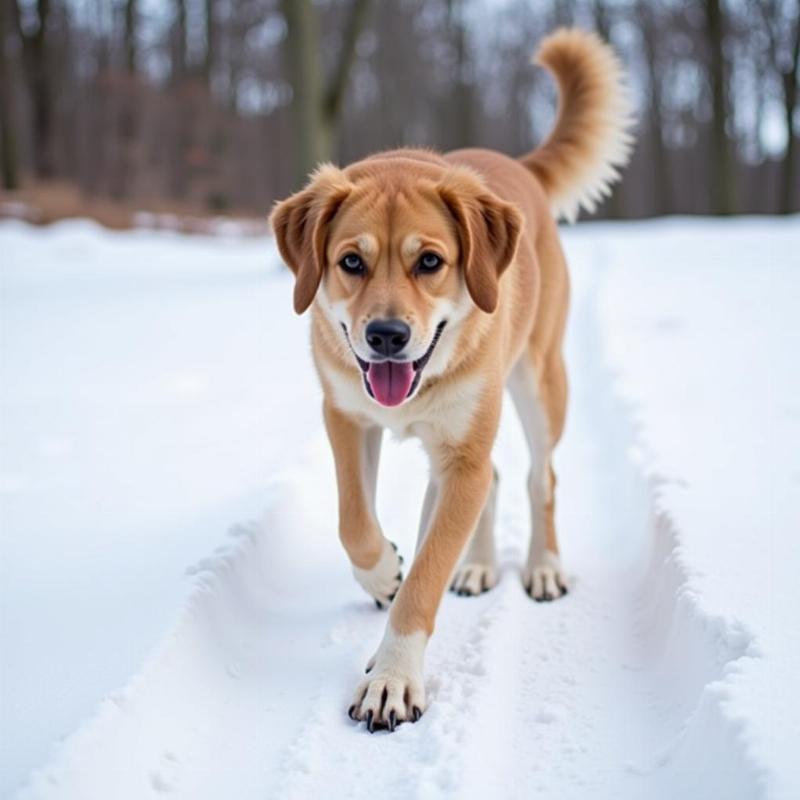Dog paw wax is a simple yet effective solution to protect your furry friend’s paws during harsh winter conditions. It provides much-needed traction on slippery surfaces like ice and snow, preventing painful slips and falls. But the benefits of dog paw wax extend beyond just traction. It also forms a protective barrier against ice, snow, salt, and other winter hazards that can irritate and damage your dog’s paw pads. Let’s explore how this essential item can improve your dog’s winter walks and overall paw health.
Why is Dog Paw Wax Important for Traction?
Winter walks can be a joyous experience for both you and your dog, but icy sidewalks and snowy paths can quickly turn that joy into a safety hazard. Dog paw wax provides a layer of grip, similar to how tire chains work for cars, helping your dog maintain balance and confidence on slick surfaces. This added traction reduces the risk of slips, falls, and injuries, allowing your dog to enjoy their winter adventures without fear.
Many dog owners in the US, especially in colder states, use paw wax regularly throughout the winter. This is because rock salt, commonly used to de-ice sidewalks, can be incredibly irritating to a dog’s paws. Paw wax acts as a shield, preventing direct contact with these harsh chemicals.
Choosing the Right Dog Paw Wax for Your Pup
Not all paw waxes are created equal. Look for a product specifically formulated for dogs, made with natural ingredients and free of harsh chemicals that could irritate their sensitive skin. Some popular ingredients include beeswax, shea butter, and coconut oil, known for their moisturizing and protective properties.
 Dog Walking on Snow with Paw Wax
Dog Walking on Snow with Paw Wax
Understanding the Different Types of Paw Wax
You’ll find various types of paw wax available, each with slightly different benefits. Some are designed for extreme cold, offering maximum protection against ice and snow, while others focus on moisturizing and healing dry, cracked paws. Consider your dog’s specific needs and the typical winter conditions in your area when making your choice.
Applying Dog Paw Wax: A Step-by-Step Guide
Applying paw wax is a quick and easy process. First, clean your dog’s paws with a damp cloth to remove any dirt or debris. Then, apply a small amount of wax to each paw pad, massaging it gently into the skin. Make sure to cover the entire paw pad and between the toes. Allow the wax to dry for a few minutes before letting your dog walk.
How Often Should You Apply Paw Wax?
The frequency of application depends on factors like how often your dog goes outside, the weather conditions, and the specific product you’re using. Generally, applying paw wax before each winter walk is recommended. You may need to reapply it more frequently during particularly harsh weather or long walks.
Beyond Traction: Additional Benefits of Dog Paw Wax
Besides providing traction, dog paw wax offers several other benefits:
- Protection against extreme temperatures: Paw wax acts as insulation against both hot and cold surfaces, protecting your dog’s paws from extreme temperatures.
- Moisturizes dry, cracked paws: Many paw waxes contain moisturizing ingredients that soothe and heal dry, cracked paws, a common problem during winter.
- Prevents snow buildup between toes: Snow and ice can accumulate between your dog’s toes, causing discomfort and even frostbite. Paw wax helps prevent this buildup.
- Protects against harmful chemicals: Paw wax creates a barrier against rock salt, de-icing chemicals, and other irritants found on sidewalks and roads.
Conclusion
Dog paw wax for traction is an essential item for any dog owner living in an area with snowy or icy winters. It provides crucial grip on slippery surfaces, preventing falls and injuries, and offers a protective barrier against harsh winter elements. By using dog paw wax, you can ensure that your furry friend’s paws stay healthy and safe throughout the winter season, allowing them to enjoy their outdoor adventures without worry.
FAQ
-
Is dog paw wax safe for my dog to lick? Most paw waxes are made with natural ingredients and are safe if ingested in small quantities. However, it’s best to prevent excessive licking to ensure the wax stays effective.
-
Can I use human hand cream instead of paw wax? While human hand cream might seem like a suitable alternative, it’s not recommended. It often contains fragrances and chemicals that can irritate a dog’s sensitive skin.
-
How do I remove dog paw wax? Paw wax typically wears off naturally. If you need to remove it, you can use a damp cloth or a pet-friendly wipe.
-
What if my dog still slips even with paw wax? Consider using dog boots in addition to paw wax for extra traction in extreme conditions. non slip booties for senior dogs
-
Can I make my own dog paw wax? Yes, there are many DIY recipes available online using natural ingredients like beeswax and coconut oil. keep dogs from slipping on wood floors
-
Where can I buy dog paw wax? You can find dog paw wax at most pet stores, online retailers, and even some grocery stores. dog slipping on hardwood floors
-
My dog has allergies. What should I look for in a paw wax? Choose a hypoallergenic paw wax formulated for sensitive skin and free of common allergens. non slip flooring for dogs
Beautdogs.us is your premier source for all things dog-related in the US. We offer expert advice on dog breeds, grooming, dog grooming in shirley ny and comprehensive care. Whether you’re a new dog owner or a seasoned pro, Beautdogs.us provides reliable information and valuable resources to help you navigate the joys and challenges of dog ownership. Contact us today for personalized support: Email: [email protected], Phone: +1 501-555-7529.